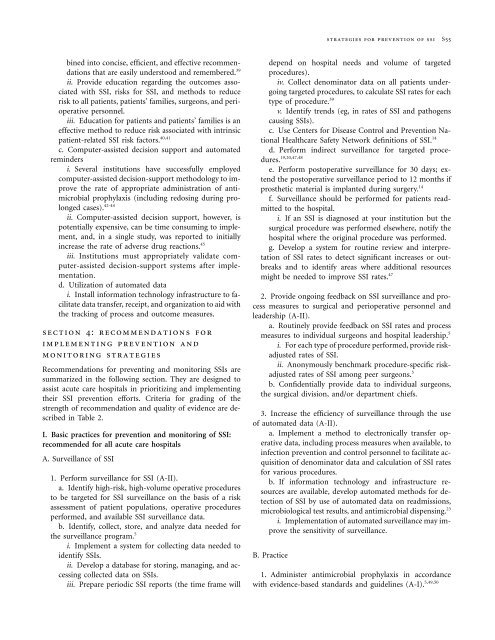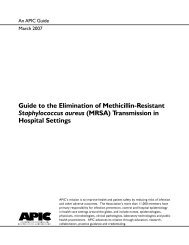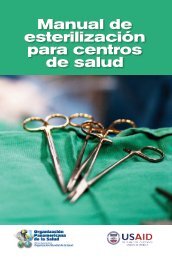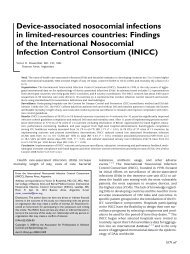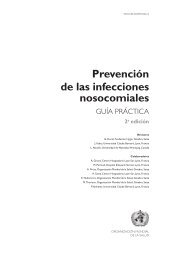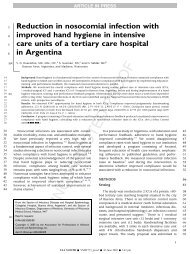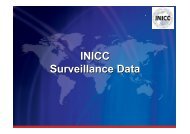Strategies to Prevent Surgical Site Infections in Acute Care Hospitals
Strategies to Prevent Surgical Site Infections in Acute Care Hospitals
Strategies to Prevent Surgical Site Infections in Acute Care Hospitals
Create successful ePaper yourself
Turn your PDF publications into a flip-book with our unique Google optimized e-Paper software.
strategies for prevention of ssiS55b<strong>in</strong>ed <strong>in</strong><strong>to</strong> concise, efficient, and effective recommendationsthat are easily unders<strong>to</strong>od and remembered. 39ii. Provide education regard<strong>in</strong>g the outcomes associatedwith SSI, risks for SSI, and methods <strong>to</strong> reducerisk <strong>to</strong> all patients, patients’ families, surgeons, and perioperativepersonnel.iii. Education for patients and patients’ families is aneffective method <strong>to</strong> reduce risk associated with <strong>in</strong>tr<strong>in</strong>sicpatient-related SSI risk fac<strong>to</strong>rs. 40,41c. Computer-assisted decision support and au<strong>to</strong>matedrem<strong>in</strong>dersi. Several <strong>in</strong>stitutions have successfully employedcomputer-assisted decision-support methodology <strong>to</strong> improvethe rate of appropriate adm<strong>in</strong>istration of antimicrobialprophylaxis (<strong>in</strong>clud<strong>in</strong>g redos<strong>in</strong>g dur<strong>in</strong>g prolongedcases). 42-44ii. Computer-assisted decision support, however, ispotentially expensive, can be time consum<strong>in</strong>g <strong>to</strong> implement,and, <strong>in</strong> a s<strong>in</strong>gle study, was reported <strong>to</strong> <strong>in</strong>itially<strong>in</strong>crease the rate of adverse drug reactions. 45iii. Institutions must appropriately validate computer-assisteddecision-support systems after implementation.d. Utilization of au<strong>to</strong>mated datai. Install <strong>in</strong>formation technology <strong>in</strong>frastructure <strong>to</strong> facilitatedata transfer, receipt, and organization <strong>to</strong> aid withthe track<strong>in</strong>g of process and outcome measures.section 4: recommendations forimplement<strong>in</strong>g prevention andmoni<strong>to</strong>r<strong>in</strong>g strategiesRecommendations for prevent<strong>in</strong>g and moni<strong>to</strong>r<strong>in</strong>g SSIs aresummarized <strong>in</strong> the follow<strong>in</strong>g section. They are designed <strong>to</strong>assist acute care hospitals <strong>in</strong> prioritiz<strong>in</strong>g and implement<strong>in</strong>gtheir SSI prevention efforts. Criteria for grad<strong>in</strong>g of thestrength of recommendation and quality of evidence are described<strong>in</strong> Table 2.I. Basic practices for prevention and moni<strong>to</strong>r<strong>in</strong>g of SSI:recommended for all acute care hospitalsA. Surveillance of SSI1. Perform surveillance for SSI (A-II).a. Identify high-risk, high-volume operative procedures<strong>to</strong> be targeted for SSI surveillance on the basis of a riskassessment of patient populations, operative proceduresperformed, and available SSI surveillance data.b. Identify, collect, s<strong>to</strong>re, and analyze data needed forthe surveillance program. 5i. Implement a system for collect<strong>in</strong>g data needed <strong>to</strong>identify SSIs.ii. Develop a database for s<strong>to</strong>r<strong>in</strong>g, manag<strong>in</strong>g, and access<strong>in</strong>gcollected data on SSIs.iii. Prepare periodic SSI reports (the time frame willdepend on hospital needs and volume of targetedprocedures).iv. Collect denom<strong>in</strong>a<strong>to</strong>r data on all patients undergo<strong>in</strong>gtargeted procedures, <strong>to</strong> calculate SSI rates for eachtype of procedure. 39v. Identify trends (eg, <strong>in</strong> rates of SSI and pathogenscaus<strong>in</strong>g SSIs).c. Use Centers for Disease Control and <strong>Prevent</strong>ion NationalHealthcare Safety Network def<strong>in</strong>itions of SSI. 14d. Perform <strong>in</strong>direct surveillance for targeted procedures.19,20,47,48e. Perform pos<strong>to</strong>perative surveillance for 30 days; extendthe pos<strong>to</strong>perative surveillance period <strong>to</strong> 12 months ifprosthetic material is implanted dur<strong>in</strong>g surgery. 14f. Surveillance should be performed for patients readmitted<strong>to</strong> the hospital.i. If an SSI is diagnosed at your <strong>in</strong>stitution but thesurgical procedure was performed elsewhere, notify thehospital where the orig<strong>in</strong>al procedure was performed.g. Develop a system for rout<strong>in</strong>e review and <strong>in</strong>terpretationof SSI rates <strong>to</strong> detect significant <strong>in</strong>creases or outbreaksand <strong>to</strong> identify areas where additional resourcesmight be needed <strong>to</strong> improve SSI rates. 472. Provide ongo<strong>in</strong>g feedback on SSI surveillance and processmeasures <strong>to</strong> surgical and perioperative personnel andleadership (A-II).a. Rout<strong>in</strong>ely provide feedback on SSI rates and processmeasures <strong>to</strong> <strong>in</strong>dividual surgeons and hospital leadership. 5i. For each type of procedure performed, provide riskadjustedrates of SSI.ii. Anonymously benchmark procedure-specific riskadjustedrates of SSI among peer surgeons. 5b. Confidentially provide data <strong>to</strong> <strong>in</strong>dividual surgeons,the surgical division, and/or department chiefs.3. Increase the efficiency of surveillance through the useof au<strong>to</strong>mated data (A-II).a. Implement a method <strong>to</strong> electronically transfer operativedata, <strong>in</strong>clud<strong>in</strong>g process measures when available, <strong>to</strong><strong>in</strong>fection prevention and control personnel <strong>to</strong> facilitate acquisitionof denom<strong>in</strong>a<strong>to</strong>r data and calculation of SSI ratesfor various procedures.b. If <strong>in</strong>formation technology and <strong>in</strong>frastructure resourcesare available, develop au<strong>to</strong>mated methods for detectionof SSI by use of au<strong>to</strong>mated data on readmissions,microbiological test results, and antimicrobial dispens<strong>in</strong>g. 23i. Implementation of au<strong>to</strong>mated surveillance may improvethe sensitivity of surveillance.B. Practice1. Adm<strong>in</strong>ister antimicrobial prophylaxis <strong>in</strong> accordancewith evidence-based standards and guidel<strong>in</strong>es (A-I). 5,49,50


